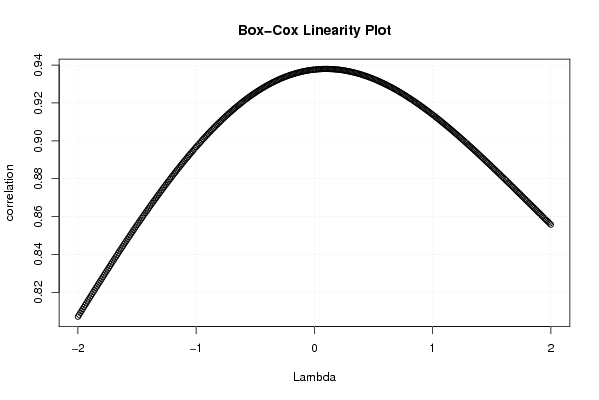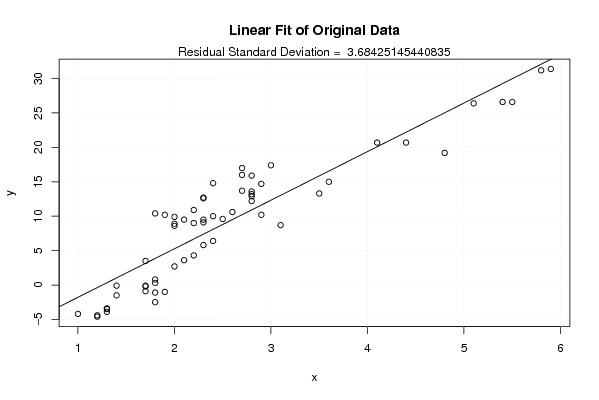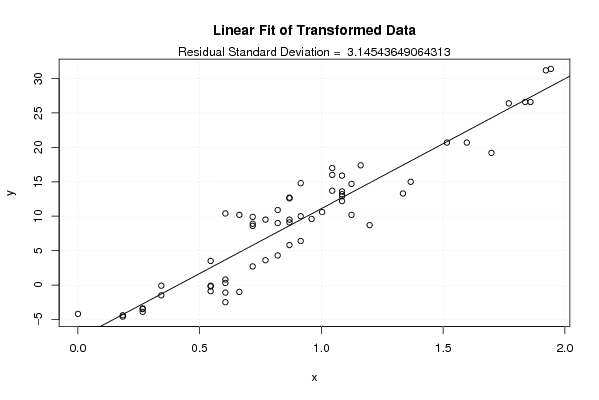Free Statistics
of Irreproducible Research!
Description of Statistical Computation | |||||||||||||||||||||||||||||||||||||||||||||
|---|---|---|---|---|---|---|---|---|---|---|---|---|---|---|---|---|---|---|---|---|---|---|---|---|---|---|---|---|---|---|---|---|---|---|---|---|---|---|---|---|---|---|---|---|---|
| Author's title | |||||||||||||||||||||||||||||||||||||||||||||
| Author | *The author of this computation has been verified* | ||||||||||||||||||||||||||||||||||||||||||||
| R Software Module | rwasp_boxcoxlin.wasp | ||||||||||||||||||||||||||||||||||||||||||||
| Title produced by software | Box-Cox Linearity Plot | ||||||||||||||||||||||||||||||||||||||||||||
| Date of computation | Tue, 11 Nov 2008 12:49:52 -0700 | ||||||||||||||||||||||||||||||||||||||||||||
| Cite this page as follows | Statistical Computations at FreeStatistics.org, Office for Research Development and Education, URL https://freestatistics.org/blog/index.php?v=date/2008/Nov/11/t1226433073jg9b5n9lh73313c.htm/, Retrieved Sat, 05 Jul 2025 18:47:56 +0000 | ||||||||||||||||||||||||||||||||||||||||||||
| Statistical Computations at FreeStatistics.org, Office for Research Development and Education, URL https://freestatistics.org/blog/index.php?pk=23904, Retrieved Sat, 05 Jul 2025 18:47:56 +0000 | |||||||||||||||||||||||||||||||||||||||||||||
| QR Codes: | |||||||||||||||||||||||||||||||||||||||||||||
|
| |||||||||||||||||||||||||||||||||||||||||||||
| Original text written by user: | |||||||||||||||||||||||||||||||||||||||||||||
| IsPrivate? | No (this computation is public) | ||||||||||||||||||||||||||||||||||||||||||||
| User-defined keywords | Bert Moons | ||||||||||||||||||||||||||||||||||||||||||||
| Estimated Impact | 199 | ||||||||||||||||||||||||||||||||||||||||||||
Tree of Dependent Computations | |||||||||||||||||||||||||||||||||||||||||||||
| Family? (F = Feedback message, R = changed R code, M = changed R Module, P = changed Parameters, D = changed Data) | |||||||||||||||||||||||||||||||||||||||||||||
| - [Box-Cox Linearity Plot] [Bert Moons - Q3 B...] [2008-11-11 10:17:28] [b6c777429d07a05453509ef079833861] F R D [Box-Cox Linearity Plot] [Bert Moons - Box-...] [2008-11-11 19:49:52] [1828943283e41f5e3270e2e73d6433b4] [Current] | |||||||||||||||||||||||||||||||||||||||||||||
| Feedback Forum | |||||||||||||||||||||||||||||||||||||||||||||
Post a new message | |||||||||||||||||||||||||||||||||||||||||||||
Dataset | |||||||||||||||||||||||||||||||||||||||||||||
| Dataseries X: | |||||||||||||||||||||||||||||||||||||||||||||
4,8 5,5 5,4 5,9 5,8 5,1 4,1 4,4 3,6 3,5 3,1 2,9 2,2 1,4 1,2 1,3 1,3 1,3 1,8 1,8 1,8 1,7 2,1 2 1,7 1,9 2,3 2,4 2,5 2,8 2,6 2,2 2,8 2,8 2,8 2,3 2,2 3 2,9 2,7 2,7 2,3 2,4 2,8 2,3 2 1,9 2,3 2,7 1,8 2 2,1 2 2,4 1,7 1 1,2 1,4 1,7 1,8 | |||||||||||||||||||||||||||||||||||||||||||||
| Dataseries Y: | |||||||||||||||||||||||||||||||||||||||||||||
19,2 26,6 26,6 31,4 31,2 26,4 20,7 20,7 15 13,3 8,7 10,2 4,3 -0,1 -4,6 -3,9 -3,5 -3,4 -2,5 -1,1 0,3 -0,9 3,6 2,7 -0,2 -1 5,8 6,4 9,6 13,2 10,6 10,9 12,9 15,9 12,2 9,1 9 17,4 14,7 17 13,7 9,5 14,8 13,6 12,6 8,9 10,2 12,7 16 10,4 9,9 9,5 8,6 10 3,5 -4,2 -4,4 -1,5 -0,1 0,8 | |||||||||||||||||||||||||||||||||||||||||||||
Tables (Output of Computation) | |||||||||||||||||||||||||||||||||||||||||||||
| |||||||||||||||||||||||||||||||||||||||||||||
Figures (Output of Computation) | |||||||||||||||||||||||||||||||||||||||||||||
Input Parameters & R Code | |||||||||||||||||||||||||||||||||||||||||||||
| Parameters (Session): | |||||||||||||||||||||||||||||||||||||||||||||
| Parameters (R input): | |||||||||||||||||||||||||||||||||||||||||||||
| R code (references can be found in the software module): | |||||||||||||||||||||||||||||||||||||||||||||
n <- length(x) | |||||||||||||||||||||||||||||||||||||||||||||

















